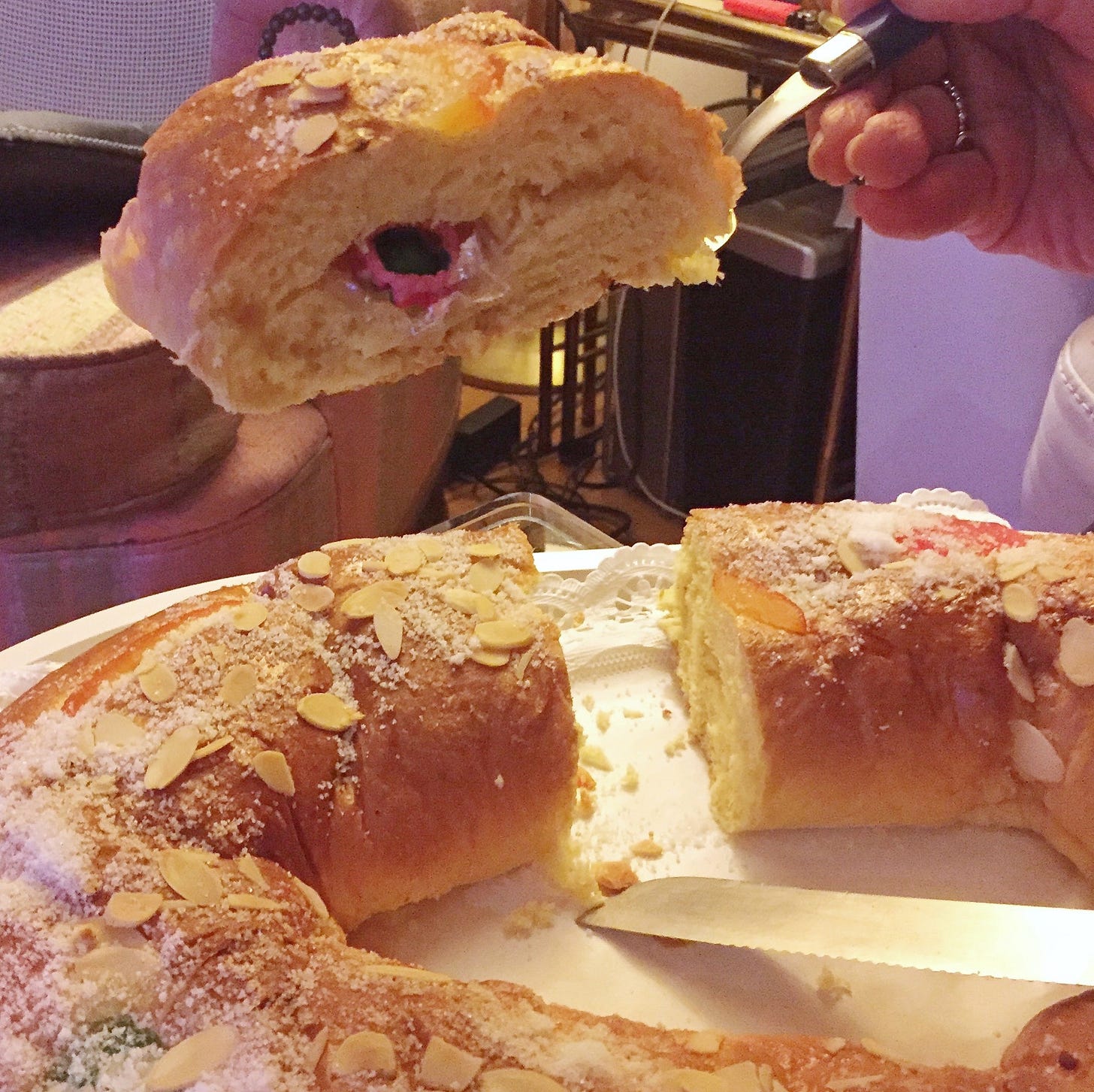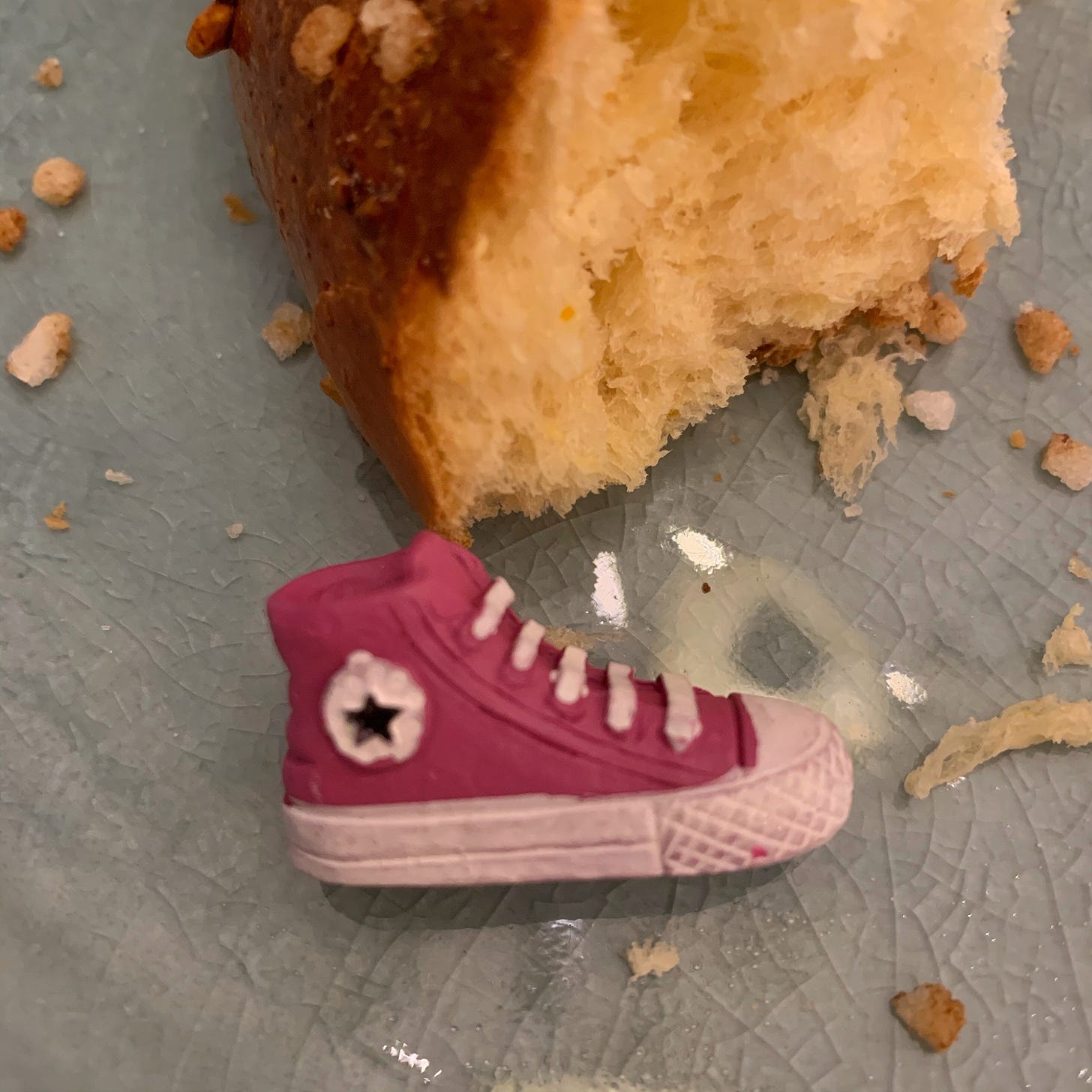Roscón de Reyes, the king of Spanish holiday treats
Superstitions and cake, two of my favorite things
I don’t like to think of myself as a superstitious person, but… I’m kind of a superstitious person. Case in point: Spain has a tradition of eating grapes as they ring in the New Year for good luck (more on this very soon!), and I took it so seriously my first year that I made David help me train in the middle of July. I wanted to make sure I was going to be able to complete the task without risking an entire year of bad luck!
Even if I don’t fully believe in the myths and rituals (if I weren’t able to eat the grapes on time, I like to think I would still have a good year), I enjoy the history and tradition behind them. So it makes sense that my favorite Spanish baked good, the most famous of Spanish Christmas treats called Roscón de Reyes, is served with a side of superstition.

Roscón de Reyes, or Kings’ Cake, is a round, bready cake that looks a bit like a supersized doughnut.1 It is traditionally decorated with a combination of crushed and/or sliced almonds, pearl sugar, and candied fruit. The cakes are either served plain, or sliced open with nata (whipped cream) slathered in the middle.
If you’re from the US, you may have heard of king cake, which is similar and served around Mardi Gras, particularly in New Orleans. To my understanding,2 there is more variation within king cakes in Louisiana vs the traditional Spanish version, but there are two things that they always have in common: the circular or oval form, and the fact that each cake has a little figure hidden inside.
And therein lies (literally) the superstition. In Spain, the bakers hide a tiny porcelain object somewhere in the dough. Whoever gets the piece of the roscón that has the sorpresa (surprise) is said to have good luck throughout the year. From my limited knowledge, this is similar to the king cake served in New Orleans, except that for Mardi Gras the figure is always a baby (representing Jesus) while in Spain, it can be literally anything. One year I got a basket full of raspberries, and another year a sneaker (my personal favorite so far).
Roscones in Spain sometimes have an additional surprise hidden inside that te puede tocar (you may find): the haba, which is a (dried) bean. This is the prize that you don’t want to find—whoever gets the haba has to pay for the roscón the next year. To be honest, the threat of having to buy a future roscón is a small price to pay for the enjoyment of the traditional Christmas treat. Plus, no one that I know actually takes this part seriously.
As I mentioned last week, Spanish Christmas goodies are all about almonds, Roscón de Reyes included. However, the sprinkled almonds on top of roscones are a mere bonus. The real star of the cake is something called agua de azahar, or orange blossom water. It’s added to the dough of the roscón and lends a subtle but imprescindible (essential) flavor that is characteristic of the cake. Be warned, though—much like cinnamon and cocoa, aqua de azahar on its own smells much better than it tastes.
In contrast to my turrón failure, Roscón de Reyes is a dessert that David and I make every year with excellent results. But similar to turrón, if you want to be successful, you have to be extremely precise, patient, and willing to put in some effort. It’s a long process that involves carefully monitoring temperatures for the ingredients themselves and for both letting the dough rise and baking it in the oven. It is definitely one of those recipes in which you need to acquiesce to science-based cooking if you want consistent results. But it’s worth it—even if you have to get up at 4am to make it happen on Christmas Day (not that we’ve done that before or anything…).
If you’re not into making your own roscón, there are tons of delicious versions in bakeries throughout Madrid. Our personal favorite is the one from Panem, and we’re also partial to the one from Moulin Chocolat. Or if you want to go for a more of-the-moment option, the winner of the best roscón de Reyes in Madrid this year was the one from Panod.
Roscón de Reyes is a treat that’s seasonal in the true sense of the word—although there may be a handful of places that serve it year-round in Madrid, it’s hard to find it outside of Navidades (Christmastime). This means two things:
If you want roscón from any of the more popular bakeries, including the ones listed above, you’re going to have to either reserve it ahead of time or get up early and stand in a long line. This especially goes for popular days for roscón indulgence, including December 24th/25th and January 5th/6th.
You have to get your entire fill of roscón within approximately a month and a half, so go a little crazy. No one’s going to judge you for eating roscón for breakfast (and merienda3) every day. I hear that you can also freeze roscón, but there's never any left when we buy/make it, so I can't personally vouch for this strategy.
Have you ever tried Roscón de Reyes or any other version of this treat? What is your stance on candied fruit? Any questions about Spanish holiday desserts? Let me know in the comments!
Since the next two Sundays are holidays, there won’t be a new Sunday Sobremesa until January 8th. If you’re interested, you can still browse and join in on previous convos by clicking here!
Happy holidays from Madrid! See you next week!
Ki
On roscones looking like doughnuts: Linguistics lesson time! According to the RAE, a rosca is something that is circular or oval-shaped and has a hole in the middle. The suffix -on can be added to a word to signify “big,” so a roscón is a big rosca. Similarly, rosquillas—which I wrote about back in May—are tiny roscas (the suffix -illa means “small”).
On Mardi Gras King Cake: I have no experience with it, and have never tried it, so if someone knows more about it, I would love to learn!
Merienda: Afternoon snack







I’d love to try it of course for me without the candied fruit. Candied fruit reminds me of fruitcake which I don’t like.
What a delicious read, Kiki! Wishing you and your family beautiful holidays! ✨ PS: it’s -8 degrees here in Chicago with a windchill of -33 🥶 a perfect day for baking!🎄❤️